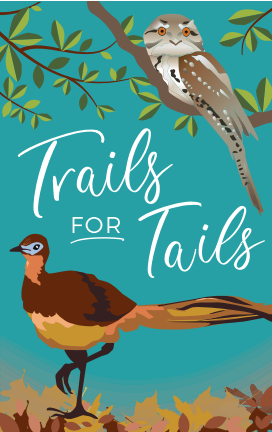Michelle, Wes and Indi's Story
Michelle, Wes and Indi's Story
“We have incredible locals on Mackellar Range whose collective knowledge is priceless and who together are making an incredible investment in conserving the biodiversity of this area. However, the job is HUGE and we need help. Grants and projects like this provide opportunity to collaborate with experts and provide pivotal initiatives that can achieve things we simply could not do alone. We have learned much from Ash and Dave already and cannot wait to see what else is ahead".

Michelle, Wes and Indi consider themselves privileged. Relishing in a 77ha forested paradise, their property forms part of the Mackellar Range – a natural corridor between Bungabee and Border Ranges national park.
It all began 17 years ago and took well over a year to find, but when Michelle and Wes first drove along their soon to be driveway… they were sold.
“When we drive through our gate the weight of the world just disappears from our shoulders, we look around us at what mother-nature has provided and realise how small our problems are in the scheme of things and we breathe.”
Thanks to like-minded neighbours, getting to know their new surroundings was easy. Identifying and managing weeds was their priority particularly in areas logged during the 1930’s. However, for the most part, the forest is relatively untouched.
Soon after they moved in, Wes saw an Albert’s Lyrebird near the house, and to his surprise, it was mimicking a barking dog. Three years ago, another Lyrebird dashed in front of their car one afternoon. So, Wes and Indi began their long walks in search of the unusual looking and rather-more -feathery, barking dog.
Then one day an incredible find, the tail feather of an Albert’s Lyrebird – proof perhaps there is more than one bird? It wasn’t until they set up a wildlife camera that they came to understand how many of these wonderful creatures call their property, home.
With it came a bevy of other shy and often nocturnal animals such as echidnas, bandicoots, goannas, skinks, pademelons, native bush rats, antechinus and a range of birds from brush turkeys to owls, log-runners and bower birds to Woompoo pigeons and emerald doves. And another great find – the endangered Long-nosed Potoroo!
It goes without saying that they love nature. Now at 12 years of age, their daughter Indi equally appreciates the property and describes it as a peaceful and tranquil place.
“It’s a lovely moment when you see your child relinquish material things and instead connect with nature. As Indi has grown, her understanding of our responsibility to look after our wild places and endangered species has become more important to her and a central part of our family fabric.”
As for the Marbled Frogmouth, the family hadn’t seen one until ecologist, Dave Milledge, conducted a survey as part of the T4T project and immediately located one calling only 50m from Wes and Michelle’s house. Funnily enough, Wes had actually heard this call before and thought it was a frog.
While all this discovery is exciting, they have also noticed a decline in some species in the last decade including red belly black snakes, goannas and small mammals – particularly the antechinus.
Although there is no apparent reason why this has occurred, continued loss of habitat in surrounding areas and an increase in feral animals (cane toad, fox, wild dog) are likely to be playing a part.
“Capturing footage of the Albert’s Lyrebird, as well as wild dogs and foxes on the same camera in the same area alarms us. Each time we look at footage we must confess to feeling very nervous that we might see something that could break our hearts a bit. However, we at least feel that working with this project we are moving towards a solution to managing the feral animals, conserving the right habitat for the native wildlife and doing the best we can to preserve all the precious mammals and bird life native to this corridor.”
